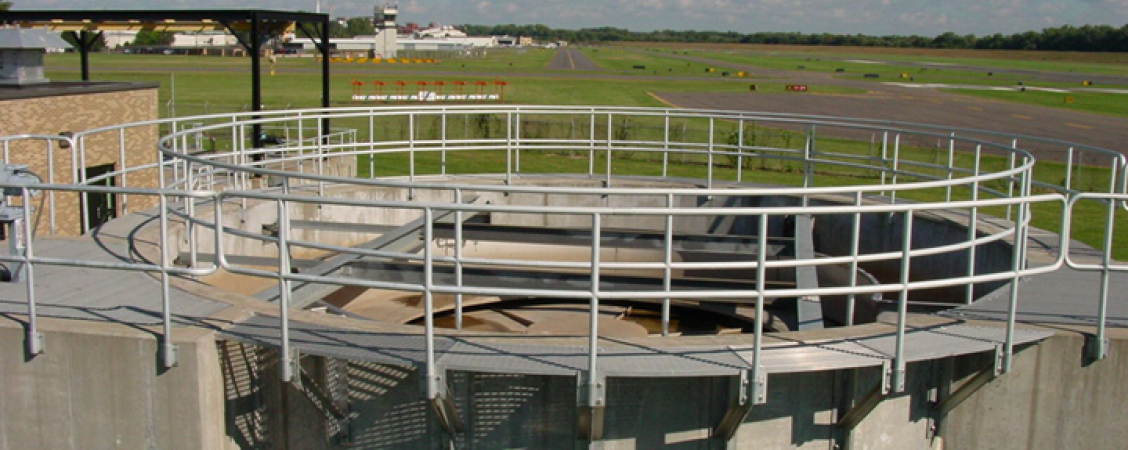Bucksport, ME Storm King Halts CSO Related Flooding
An 18’ (5.5 m) diameter Storm King® system used as satellite treatment was smaller, more economical, and more efficient than conventional…

Prevent 100% of combined sewer floatables and gross solids and 95% of grit and sediment from reaching the environment.
The Storm King® is an advanced hydrodynamic vortex separator that delivers exceptional removal of TSS, BOD and other materials at combined sewer overflow sites, preventing damaging pollutants from reaching the environment during heavy rainfall and surge events.
A small-footprint, non-powered, low-maintenance unit with low capital and O&M costs, the Storm King® is ideal for satellite treatment at overflow sites and can reduce project costs by up to 50% compared to conventional technologies.
If you’re based in North America, please view this page on oldcastleinfrastructure.com. Hydro International and Oldcastle Infrastructure are CRH companies.
The Storm King® is an advanced hydrodynamic vortex separator and floatables control device that delivers exceptional removal of TSS, BOD and other materials at Combined Sewer Overflow (CSO) sites, preventing damaging pollutants from reaching the environment during heavy rainfall and surge events.
The Storm King® hydrodynamic separator achieves exceptional removal of CSO pollutants, delivering 100% removal of floatables and gross pollutants and 95% removal of grit and sediment.
A small-footprint, non-powered, low-maintenance unit with low capital and O&M costs, the Storm King® is ideal for satellite treatment at overflow sites and can reduce project costs by up to 50% compared to conventional technologies. And with Hydro-Logic® Smart Monitoring technology you can rest assured that it's performing and protecting the environment exactly as designed at all times.
The Storm King® delivers 100% removal in two directions of gross solids, floatables and neutrally buoyant material larger than ¼ in (6mm), and achieves 95% removal of TSS and BOD - equivalent to primary treatment.
The Storm King® incorporates a hydrodynamic separator to ensure exceptional removal of CSO pollutants, and trials conducted in the USA at Columbus, GA and Saco, ME show that the unit can also be used to provide disinfection in 30% of the area normally required for conventional disinfection technologies - enabling the system to provide multiple treatment functions in a single unit.
The Storm King® is a small-footprint, non-powered, low-maintenance unit with low capital and O&M costs, and offers up to 50% project cost savings when compared with conventional technologies such as micro-strainers.
With no moving parts and no power requirements, the Storm King® is a low-maintenance CSO treatment and wastewater management solution.
An 18’ (5.5 m) diameter Storm King® system used as satellite treatment was smaller, more economical, and more efficient than conventional…
Satellite treatment using Storm King® Separators at two CSO locations resulted in an estimated $20-30 million saving in project capital…
A Storm King® CSO treatment system improved water quality at a culturally important lake in Chaohu, China. Situation The Chinese…
Retrofit self-cleansing screens enable three Storm King® hydrodynamic vortex separators to meet the 6 mm in two direction screening…
Storm King® helped the town of Namur, Belgium to prevent sewer overflows from its state-of-the-art Brumagne sewage treatment works and meet…
The required diameter of a Storm King is a function of the peak design inflow rate, design removal performance and the available depth. Within defined design limits, unit diameter can be increased to counteract the effect of limited available depth. Please contact us to discuss your project requirements.
The performance efficiency of a hydrodynamic separator depends on the physical size of the unit (and consequently retention time) and on the settleability of the incoming sewage; purely neutrally buoyant material cannot be removed by gravitational forces alone. A hydrodynamic separator typically achieves the same removal performance as a primary sedimentation tank in a quarter of the plan area.
Higher loading rates can be used when less efficient performance is required, e.g. at a treatment works where grit and silt needs to be removed but where it is beneficial for finer fecal material to pass forward to further downstream treatment processes.
No, separate Hydro-Brake® flow controls are typically used to control the pass-on flow rate to treatment.
If a gravitational system is unobtainable then a pump can be used to control the pass-on flow to treatment as an alternative to the Hydro-Brake® flow control.
Keep your Hydro International water management systems running effectively and efficiently. Our services teams will supply you with…